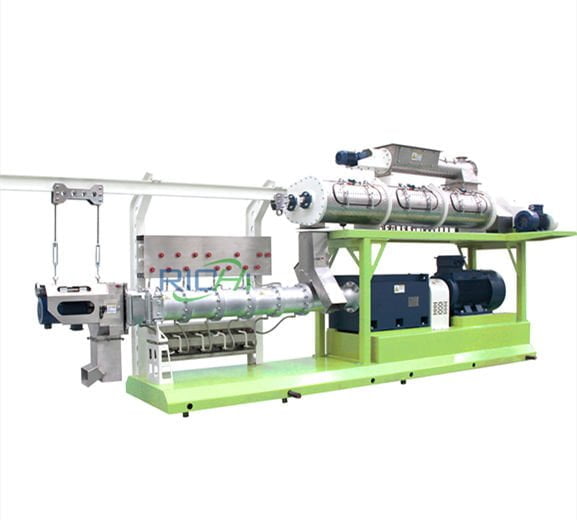Production process of floating fish feed making machine
With the rapid development of the aquaculture industry, traditional farming methods have been far from meeting people's needs. The requirements ... View MoreProduction process of floating fish feed making machine
With the rapid development of the aquaculture industry, traditional farming methods have been far from meeting people's needs. The requirements for aquaculture fish feed made by floating fish feed making machine are not only balanced nutrition, good stability of the feed in water, no pollution to water quality, etc., and more stringent requirements are put forward for the environmental quality of fish survival.
The feed produced by the aquaculture floating fish feed making machine is hard pellets, and the other is the extruded feed pellet machine, and the processed fish feed is soft pellets.
Today, Richi Machinery will talk about the extruded feed floating fish feed making machine. The production process generally adopts secondary crushing and secondary ingredient mixing, and then passes through extrusion, drying, external spraying, cooling, crushing and screening to complete the processing of aquatic extruded feed.
1. Raw material cleaning and primary grinding
There are generally two forms of raw materials used in floating fish feed factories: one is powder, which does not need to be coarsely pulverized. For this kind of raw material, it can directly enter the conical cleaning screen to remove impurities after passing through the feeding pit and elevator, and then conduct magnetic separation, and directly enter the batching bin through the distributor or screw auger to participate in the first batching;
The material that needs to be coarsely pulverized---granular material. This kind of material enters the cleaning equipment through the unloading pit and the elevator to enter the cleaning equipment for magnetic separation of impurities, and then enters the to-be-pulverized bin.
For individual raw materials, such as shrimp shells, they can be directly put into the silo to be crushed after magnetic separation without initial sieving.
One-time coarse pulverization is the pretreatment process of ultrafine pulverization in aquatic feed processing. Its main purpose is to reduce the pellet size difference and variation range of materials, improve the working condition of the ultrafine pulverizer, and improve the working efficiency and guarantee of the ultrafine pulverizer.
The product quality is stable; at the same time, in order to improve the working environment of workers and reduce cross-contamination, it is recommended to use an independent dust removal air net, that is, an independent dust removal system for the feeding port.
2. The first batching and mixing
The first batching is mainly the preparation of public raw materials, that is, the preparation of larger materials in the formula. This floating fish feed making machine process is mainly completed by electronic batching scales.
However, in the first batching process, special attention should be paid to the arching problem of the batching bin, which is mainly caused by the light bulk density and poor fluidity of the raw materials of the aquatic feed, especially the high-grade aquatic feed raw materials. Therefore, certain anti-arching measures should be taken for the batching bin, such as the use of eccentric discharge, vibration motor, etc.
The single-shaft horizontal ribbon mixer can be used for the first mixing, and the grease addition system must be considered on the mixer. The first batching and mixing is also the pre-treatment process of ultra-fine pulverization.
This auxiliary equipment of floating fish feed making machine is mainly to reduce the variation range of material pellet size, improve the working condition of the pulverizer, improve the working efficiency of the pulverizer, and ensure the quality of the product.
3. Secondary crushing and mixing of secondary ingredients
Due to the low food intake, short digestive tract and poor digestive ability of aquatic animals, aquatic feed requires very fine crushing pellet size to increase the surface area of the feed, increase the contact area between the digestive juice of aquatic animals and the feed, and improve the ability of aquatic animals to feed the feed.
At the same time, due to the low intake of aquatic animals, the mixing uniformity of the feed is required to be reflected in a smaller range, which also requires the aquatic feed to have a finer pellet size.
For example, the shrimp feed should all pass through the 40-mesh analytical sieve, and the content on the 60-mesh sieve should be less than 5%, so the micro-grinding process must be adopted.
In the secondary pulverization process, the materials mixed in the first time are lifted by the elevator and then enter the silo to be pulverized, and then enter the micro pulverizer. Micro-pulverizers are generally used in the processing of aquatic feeds, and vertical-axis micro-pulverizers are generally used, which are equipped with powerful wind separation equipment, and then enter the rotary grading screen for screening.
The purpose of configuring the rotary grading screen here is mainly to remove the fine fluff formed by the coarse fibers in the feed during the pulverization process, because the existence of these fine fluff is easy to adhere to the die hole of the floating fish feed making machine until the die hole is blocked, causing Shut down for cleaning, so it must be removed.
The cleaned materials are subjected to secondary batching and mixing. Since the fineness of the materials entering the secondary batching mixing bin is above 60 mesh and the density is small, special attention should be paid to the phenomenon of arching.
In order to prevent this phenomenon, on the one hand, the eccentric sub-expansion hopper can be used, and on the other hand, all the material discharge machines that have undergone ultra-fine grinding use an impeller feeder, which not only has an arch breaking mechanism, but also can flexibly adjust the flow rate. size. Various raw materials enter the secondary mixer after secondary batching.
There is an artificial feeding port above the secondary mixer, which is mainly used for the addition of trace additives. At the same time, there is a liquid addition mechanism on the mixer for the addition of grease; one is for the addition of water. In the secondary mixing process, various materials must be fully mixed, and the coefficient of variation CV is less than 7%, which is the key to ensuring product quality.
Therefore, the mixer must choose a model with excellent performance, such as double-shaft horizontal paddle mixing It has high mixing uniformity, high output and fast mixing speed. After secondary crushing and secondary ingredient mixing, the material enters the subsequent process---expansion granulation process---with floating fish feed making machine.
4. Extrusion process by floating fish feed making machine
In the extrusion process, the material actually undergoes a cooking process under the conditions of high temperature, high humidity and high pressure.
During this floating fish feed making machine process, the physical and chemical properties of the material changed strongly, and at the moment when the material was extruded from the die hole, the water in the feed was immediately converted from liquid to gaseous state and emitted from the feed because the pressure suddenly dropped from high pressure to about 100kPa.
Thereby, the material is extruded by floating fish feed making machine to form the so-called extruded feed. Because this kind of feed not only has the advantages of general hard pellet feed - good palatability, avoids automatic grading of products, is easy to transport, helps digestion, reduces waste in the feeding process, etc., but also has unique advantages:
In the feed, the starch has a high degree of gelatinization by floating fish feed making machine, the protein is more digestible, and the utilization rate of the animal feed is improved; it has excellent floatability, which is easy to observe the feeding situation of the fish, and can control the water pollution to the maximum extent. These are also the main reasons why extruded feed is widely used.
There are many kinds of dryers can be used after floating fish feed making machine. When the diameter of the pellets is less than 4mm, a vibrating fluidized bed dryer can be selected; when the diameter of the pellets is greater than 4mm, a belt dryer can be selected, or a horizontal float dryer can be directly selected.
Because this kind of dryer can make the material in a semi-suspended state on the entire screen surface, it can not only ensure the drying effect, but also minimize the damage to the pellets. After the material is dried, it enters the external spraying system.
The external spraying of the pellets is mainly to meet the fish's energy needs and reduce the loss of heat-sensitive substances during processing. The nutrients that should not be added in the previous process can be supplemented by external spraying, and at the same time, the palatability of the feed can be improved and the powder content can be reduced.
The optimum working temperature for this process is around 80℃. After the material passes through the external spraying system, it can enter the counter-flow cooler for cooling.
5. Finished product packaging
The cooled material is lifted by the elevator and then crushed into the plane rotary screen for classification. The grading sieve used after floating fish feed making machine is generally a two-layer sieve, and the material on the lower sieve is the finished product, which can be directly entered into the finished product warehouse, and then weighed and packaged. The material on the upper sieve needs to be returned to the crusher for crushing. The material under the lower sieve is generally finely crushed, which can be returned to the batching bin as waste.
The floating fish feed making machine production process analyzed above is the conventional configuration of the current aquatic extruded feed processing technology. Using this process, sinking feed, slow sinking feed and floating feed can be produced.
Although extruded floating fish feed making machine technology has been recognized by many manufacturers as a new type of processing technology, it has not been widely used because its investment is much larger than that of hard pellet feed processing technology.
Nevertheless, the floating fish feed making machine puffing process is the future development trend of the feed processing industry, especially in the application of aquatic animal feed and pet feed, and will definitely replace the traditional hard pellet feed processing technology.
I hope the above related content about floating fish feed making machine is helpful to you. For more information about floating fish feed pellet making machine, you are welcome to consult the staff of Richi Machinery, we will serve you wholeheartedly! More infomation on website: https://www.richipelletmachine.com/floating-fish-feed-making-machine/
Floating Fish Feed Making Machine - RICHI Pellet Machine
We provide you with the industry's first-class floating fish feed making machine and a complete set of floating fish feed plants solutions.
page=1&callback_module_id=pages&callback_item_id=18743&year=&month=
Load More











